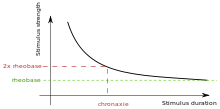Chronaxie
Chronaxie is the minimum time required for an electric current double the strength of the rheobase to stimulate a muscle or a neuron.
Chronaxie is the tissue-excitability parameter that permits choice of the optimum stimulus pulse duration for stimulation of any excitable tissue.
The terms "chronaxie" and "rheobase" were first coined in Louis Lapicque's famous paper on Définition expérimentale de l'excitabilité that was published in 1909.
It is the most simplistic of the 2 'simple' mathematical descriptors of the dependence of current strength on duration, and it leads to Weiss' linear charge progression with d: Both Lapicque's own writings and more recent work are at odds with the linear-charge approximation.
The latter may fit well also more complex models of the excitable membrane, which take into account ion-channel gating mechanisms, as well as intracellular current flow, which may be the main contributors for deviations from both simple formulas.
This example of the preponderating influence which the condition of the skin and the underlying tissues may exert compels caution in judging the results of chronaxie measurements by percutaneous stimulation.
The chronaxie times reported for soma and dendrites have been established using intracellular pulses that cannot be readily extrapolated to extra- cellular stimuli.
Data reported in the literature use either motor response as the physiological threshold in humans or action potential generation in animals.
The chronaxie values for human denervated skeletal muscle ranges from 9.5 to 30 ms at body temperature, representing a ratio of 3.16.
[7] The main value of chronaxie is comparing excitability across different experiments and measurements using the same standard, thus making data comparisons easier.
[8] Chronaxie and excitability values' medical application is electromyography, a technique for evaluating and recording the electrical activity produced by skeletal muscle.
It is difficult to see, however, how such an alteration of resistance could lead to the increased excitability to mechanical stimuli unless it is that these reactions are reflexes through the proprioceptive nerves.
[11] Acute intoxication of rats with aldrin decreases chronaxie, whereas chronic exposure to this chlorinated hydrocarbon insecticide has the reverse effect.
Chronic exposure of rats to the closely related epoxide, dieldrin, has been suggested to reduce their muscular efficiency in performing a work exercise.
Among the diverse symptoms resulting from intoxication are muscular twitching, increasing in severity to epileptiform convulsions with loss of consciousness.
Strychnine, which has a spinal locus of activity, causes tonic hind limb extension in mice, which is thought to be due to a removal of the effect of inhibitory interneurons on the nervous pathway to extensor muscles.
